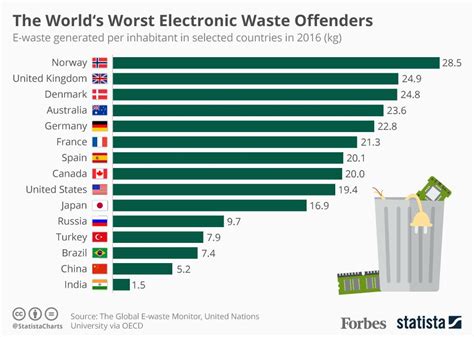

How Much E-Waste is Recycled in 2025?
Understanding the E-Waste Landscape
Electronic waste, commonly known as e-waste, refers to discarded electrical or electronic devices. Due to their complex composition, e-waste poses significant environmental and health hazards. Recycling plays a crucial role in managing these hazardous materials effectively.

Global E-Waste Generation and Recycling Rates
According to the United Nations Environment Programme (UNEP), the global generation of e-waste reached an astonishing 53.6 million metric tons (Mt) in 2019. However, only a mere 17.4% of this e-waste was formally recycled, leaving a vast majority of it unaccounted for.
Table 1: Global E-Waste Generation and Recycling Rates
| Year | E-Waste Generation (Mt) | Recycling Rate (%) |
|---|---|---|
| 2019 | 53.6 | 17.4 |
| 2025 (Projected) | 74 | 25-30 |
Key Challenges in E-Waste Recycling
Despite the growing awareness of e-waste management, several barriers hinder the efficient recycling of these devices:
- Lack of Awareness and Infrastructure: Many individuals and businesses remain unaware of the environmental risks associated with e-waste disposal and the availability of recycling options. Inadequate infrastructure in developing countries further exacerbates the problem.
- Complex Composition: E-waste contains a mix of materials, including plastics, metals, and hazardous substances. This complex composition makes it challenging to separate and extract valuable materials during the recycling process.
- High Recycling Costs: Recycling e-waste involves sophisticated processes and incurs significant costs. This cost factor discourages recyclers from investing in large-scale recycling operations.
- Illegal Dumping and Transboundary Movements: Illegal dumping and the transboundary movement of e-waste remain prevalent, leading to environmental contamination and posing risks to human health.
Future Trends and Innovations
Despite the challenges faced, the global e-waste recycling industry is expected to witness significant growth in the coming years. Here are some emerging trends and innovations:
- Increased Regulation and Standards: Governments worldwide are implementing stricter regulations to enforce responsible e-waste management practices, encouraging recycling and deterring illegal disposal.
- Technological Advancements: Innovations in recycling technologies are improving the efficiency and cost-effectiveness of the process. Artificial intelligence (AI) and automated sorting systems are revolutionizing the separation and recovery of materials.
- Extended Producer Responsibility (EPR): EPR schemes hold manufacturers accountable for the end-of-life management of their products, encouraging design for recycling and promoting sustainable consumption.
Key Players and Case Studies
Several organizations are leading the charge in e-waste recycling and promoting sustainable practices:
- Apple: Apple’s “Renew” program offers trade-in and recycling options for its products, emphasizing the importance of responsible e-waste management.
- Dell: Dell’s “Reclaim” initiative provides free recycling services for all Dell products and encourages the collection of e-waste from other sources.
- Best Buy: Best Buy operates a nationwide e-waste recycling program, accepting a wide range of electronic devices at no charge.
Case Study: Circular Economy Approach in the EU
The European Union has adopted a circular economy approach to address e-waste management. This approach focuses on reducing waste, maximizing resource utilization, and promoting reuse and recycling. The EU’s “Waste Electrical and Electronic Equipment (WEEE)” Directive sets targets for e-waste collection and recycling, encouraging innovation and fostering collaboration among stakeholders.
Benefits of E-Waste Recycling
Recycling e-waste offers numerous benefits to the environment and society:
- Preservation of Natural Resources: Recycling e-waste recovers valuable materials, including metals, plastics, and glass, reducing the need to extract new resources.
- Environmental Protection: Responsible e-waste disposal prevents the release of toxic substances into the environment, protecting wildlife and human health.
- Job Creation: The e-waste recycling industry generates employment opportunities, creating jobs in waste collection, processing, and manufacturing.
Conclusion
The responsible management of e-waste is essential for safeguarding the environment and promoting a circular economy. While the global recycling rate of e-waste remains low, significant progress is being made through increased awareness, technological advancements, and policy initiatives. By adopting best practices, collaborating with stakeholders, and embracing innovation, we can accelerate e-waste recycling and create a more sustainable future.
FAQs
1. What is the estimated global e-waste generation rate in 2025?
The global e-waste generation rate is projected to reach approximately 74 Mt by 2025.
2. What are the main reasons behind the low recycling rate of e-waste?
The lack of awareness, inadequate infrastructure, complex composition of e-waste, and high recycling costs are key factors contributing to the low recycling rate.
3. What are some emerging trends in the e-waste recycling industry?
Increased regulation, technological advancements, and the adoption of Extended Producer Responsibility (EPR) are notable trends in the e-waste recycling industry.
4. How does the circular economy approach contribute to e-waste management?
The circular economy approach emphasizes reducing waste, maximizing resource utilization, and promoting reuse and recycling, creating a sustainable model for e-waste management.
5. What are the benefits of recycling e-waste?
Recycling e-waste preserves natural resources, protects the environment, and creates employment opportunities.
6. What are some ways to improve the recycling of e-waste?
Educating the public about the importance of e-waste recycling, improving infrastructure, investing in research and development, and strengthening enforcement of regulations can enhance e-waste recycling.
7. What are the challenges involved in recycling e-waste?
The complex composition of e-waste, technological limitations, contamination, and economic factors present challenges in recycling e-waste.
8. What are the projected recycling rates of e-waste in 2025?
The projected recycling rates of e-waste in 2025 are estimated to be between 25-30%, indicating a significant increase from the current rate of 17.4%.










